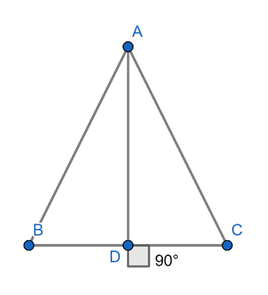If ABC is an isosceles triangle and D is a point on BC such that![]() , then
, then
Given ABC is an isosceles triangles and AD ⊥ BC.

We know that in an isosceles triangle, the perpendicular from the vertex bisects the base.
∴ BD = DC
We know that the Pythagoras theorem state that in a right angled triangle, the square of the hypotenuse is equal to the sum of the squares of the other two sides.
Now, in right triangle ABD,
⇒ AB2 = AD2 + BD2
⇒ AB2 – AD2 = BD2
⇒ AB2 – AD2 = BD (BD)
Since BD = DC,
∴ AB2 – AD2 = BD (DC)
1